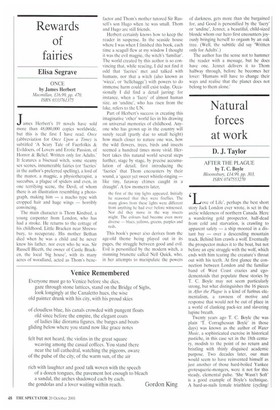Rewards of fairies
Elisa Segrave
ONCE by James Herbert Macmillan, f16.99, pp. 470, ISBN 0333761375 James Herbert's 19 novels have sold more than 48,000,000 copies worldwide, but this is the first I have read. Once (abbreviation for Once Upon a Time) is subtitled 'A Scary Tale of Faerfolkis & Evildoers, of Lovers and Erotic Passion, of Horror & Belief. Written only for Adults.' It features a bisexual witch, some steamy sex scenes, innumerable fairies (or laeries' in the author's preferred spelling), a lord of the manor, a magpie, a physiotherapist, a succubus, a plague of spiders and even, in one terrifying scene, the Devil, of whom there is an illustration resembling a photograph, making him — a macho type with cropped hair and huge wings — horribly convincing.
The main character is Thom Kindred, a young carpenter from London, who has had a stroke. He returns to the cottage of his childhood, Little Bracken near Shrewsbury, to recuperate. His mother Bethan died when he was a child and he never knew his father, nor even who he was. Sir Russell Bleeth, the owner of Castle Bracken, the local 'big house', with its many acres of woodland, acted as Thom's bene
factor and Thom's mother tutored Sir Russell's son Hugo when he was small. Thom and Hugo are still friends.
Herbert certainly knows how to keep the reader in suspense. In the seaside house where I was when I finished this book, each time a seagull flew at my window I thought it was the evil magpie, the witch's 'familiar'. The world created by this author is so convincing that, while reading, I did not find it odd that laeries' met and talked with humans, nor that a witch (also known as `wicca', or liellehagge) with powers to do immense harm could still exist today. Occasionally I did find a detail jarring: for instance, when a laery' of almost human size, an `undine', who has risen from the lake, refers to the UN.
Part of Herbert's success in creating this imaginative 'other' world lies in his drawing on universal memories of childhood. Anyone who has grown up in the country will surely recall (partly due to small height) how much closer to nature one was, how the wild flowers, trees, birds and insects seemed a hundred times more vivid. Herbert takes this natural world several steps further, stage by stage, by precise accumulation of detail, first introducing the laeries' that Thom encounters by their sound. a 'queer yet sweet whistle-ringing — like tiny, faraway chimes caught in a draught'. A few moments later,
the first of the tiny lights appeared. Initially he reasoned that they were fireflies. The many glows from these lights were different from anything he had ever before witnessed. Nor did they move in the way insects might. The colours had become even more diverse — blues, yellows, greens, purples and reds.
This book's power also derives from the age-old theme being played out in its pages, the struggle between good and evil. Evil is personified by the modern witch, a stunning brunette called Nell Quick, who, in her attempts to manipulate the powers
of darkness, gets more than she bargained for, and Good is personified by the laery' or `undine', Jennet, a beautiful, child-sized blonde whom our hero first encounters joyously bringing herself to orgasm by an oak tree. (Well, the subtitle did say 'Written only for Adults'.)
The author has the sense not to hammer the reader with a message, but he does have one. Jennet delivers it to Thom halfway through, before he becomes her lover: 'Humans will have to change their ways and realise that the planet does not belong to them alone.'


























































































 Previous page
Previous page